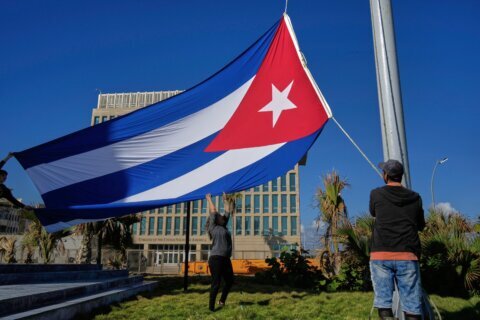The sons of a former Fort Detrick scientist who fell to his death from a New York City hotel window under mysterious circumstances are suing the federal government, claiming their father was murdered.
Nils and Eric Olson filed suit Wednesday in U.S. District Court, seeking unspecified monetary damages in the death of Frank Olson, a former civilian bioweapons scientist involved in then-top-secret CIA experiments at Detrick. They are also seeking access to CIA documents related to his death, which they say have been withheld from the family for nearly 60 years.
Olson died Nov. 28, 1953, after falling from the 10th floor of the Statler Hotel. The agency told Olson’s family he was in New York to receive psychiatric treatment because he might pose a danger to them, according to the 22-page complaint filed by attorney Scott D. Gilbert.
Just four days before his death, Olson was given LSD without his knowledge while at a conference at Deep Creek Lake. The administering of the drug to Olson and others is believed to be part of a series of secret programs conducted in the ’50s and ’60s. The programs involved experiments with biological warfare and mind control that included giving LSD and other drugs to often unwitting subjects. Many of the secret programs were exposed in 1975 and 1976 by a congressional committee delving into activities by the United States’ intelligence services. Olson was part of a program called MK-ULTRA.
While the CIA concluded that Olson’s death was directly related to the LSD experiment, the agency has long maintained Olson jumped to his death.
Olson was sharing a room with Dr. Robert Lashbrook, who was ordered to put the LSD in a bottle of liquor from which Olson and others drank at the Deep Creek Lake conference. According to the complaint, Lashbrook called his superiors instead of police after Olson fell from the window and later gave conflicting accounts of what happened that morning.
The circumstances of Olson’s death closely resemble techniques put forth in a CIA manual that same year for conducting secret assassinations, the complaint alleges. The manual suggests that a fall from at least 75 feet after a blow to the temple with a blunt object is an effective technique for carrying out such a killing. It also states that alcohol can be used to prepare the victim for the contrived accident. The complaint states that Olson and Lashbrook each had two martinis before going to bed the night before Olson’s death.
The plaintiffs allege that Olson was struck in the head before his death, and that the injury was covered up by the CIA, which insisted on a closed-casket funeral, telling the family that Olson’s body was badly disfigured.
According to the complaint, Olson expressed reservations about some of the activities in which he was involved — including violent interrogations during which prisoners were killed with biological agents he had developed — and had expressed his desire to resign. His superiors began to view him as a potential threat to national security, the plaintiffs allege.
The family received a $750,000 settlement from the government in 1975, as well as documents pertaining to Olson’s death. But the family believes there are more documents that have remained hidden.
The CIA and disclosures
Leonard Latkovski, a professor of history at Hood College, said agencies like the CIA have a history of withholding documents like those being sought by the Olson family. He said officials often use parsed language to suggest they could not find more documents, but not that they don’t exist, and that those released typically tell only part of the story.
“The pattern of agencies like the CIA is to give you things in bits and pieces,” Latkovski said. “When they say they’re releasing everything they have or the complete file, that’s not true. I don’t know that there are really any cases where it’s been true.”
Agencies have also been known to destroy documents that could implicate them or their employees in wrongdoing, he said. Former CIA Director Richard Helms ordered the destruction of files about the agency’s drug experiments, and he also destroyed his own files, according to Helms’ 1979 biography, “The Man Who Kept the Secrets,” by Thomas Powers.
Latkovski said there is a larger issue at stake in the Olsons’ lawsuit: the idea that government officials should be accountable to the citizens it purports to serve.
“If we are really a democracy, then individuals in the government who serve the people should be held accountable for their wrongdoing,” he said.
An author’s opinion
Hank Albarelli Jr., author of the 2009 book “A Terrible Mistake: The Murder of Frank Olson and the CIA’s Secret Cold War Experiments,” said he isn’t sure what the brothers and their attorney hope to gain from another lawsuit.
“I was kind of surprised, and my first thought was ‘déjà vu all over again,'” said Albarelli, who believes Olson crashed through the window during a struggle with Lashbrook. He said Lashbrook was trying to take Olson against his will to a mental hospital.
Albarelli believes Olson, who he said had started to talk about his work to unauthorized people, was given the LSD in an attempt to interrogate him based on the belief that he was a threat.
But the major players, including Lashbrook and program supervisor Sidney Gottlieb, are dead and any incriminating documents have probably been destroyed, Albarelli said, making a successful lawsuit seem unlikely.
“It’s late in the game for a suit,” he said. “Where can a lawsuit go? How do you build a case?”
Albarelli said he believes the release of his book helped spur the decision to sue.
“I don’t see where you would have any case without it,” said Albarelli, who interviewed Lashbrook and Gottlieb.
“It makes me kind of uncomfortable, to be quite honest with you.”
A review of the book posted on the CIA’s website panned Albarelli’s account for lacking evidence for murder charges.
“Those who demand documentation for such serious charges will discover that investing time to find it in Albarelli’s narrative would be a terrible mistake,” the reviewer wrote.
In an email, CIA spokeswoman Jennifer Youngblood said that while the agency doesn’t comment on matters before U.S. courts, “CIA activities related to MK-ULTRA have been thoroughly investigated over the years, and the agency cooperated with each of those investigations.” She noted that tens of thousands of pages related to the program have been released to the public.
In a statement, Eric Olson said the CIA has not given a complete picture of what happened to his father.
“The evidence shows that our father was killed in their custody,” he said. “They have lied to us ever since, withholding documents and information, and changing their story when convenient.”
The brothers could not be reached for comment at their homes or through phone calls and emails Thursday. Gilbert was unavailable Thursday because he was traveling, his firm said.
The Associated Press and staff writer Danielle E. Gaines contributed to this report.







